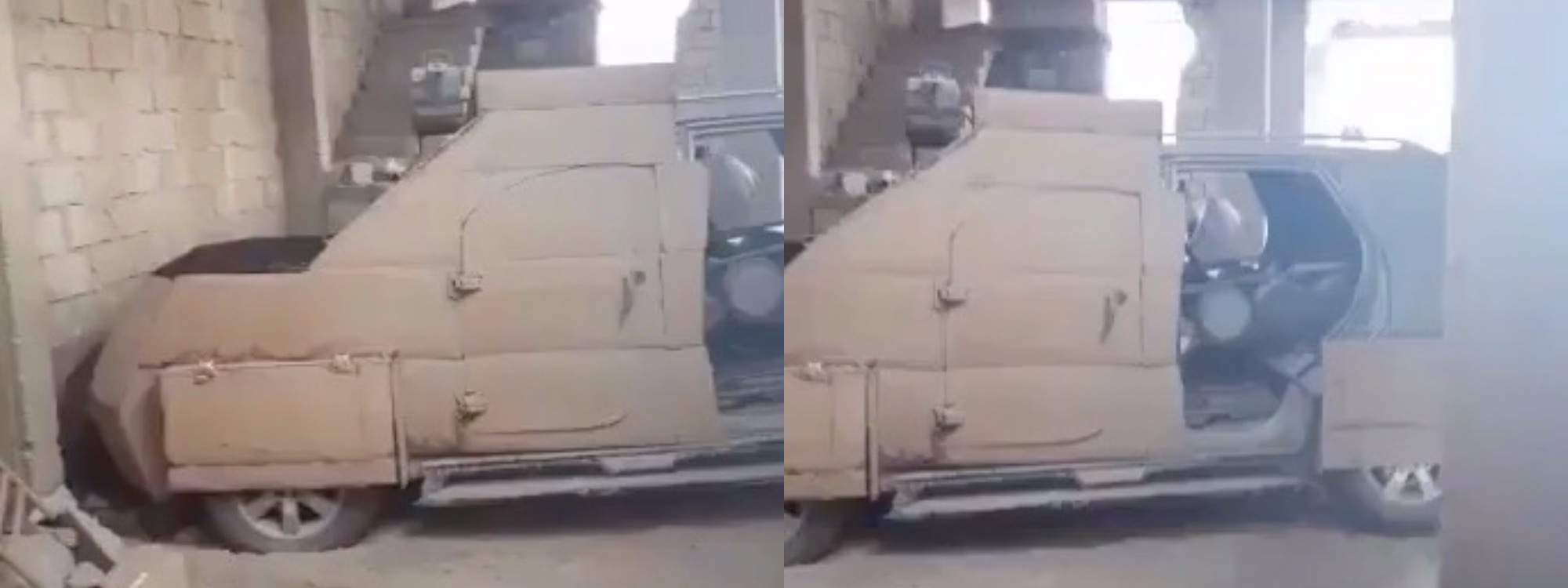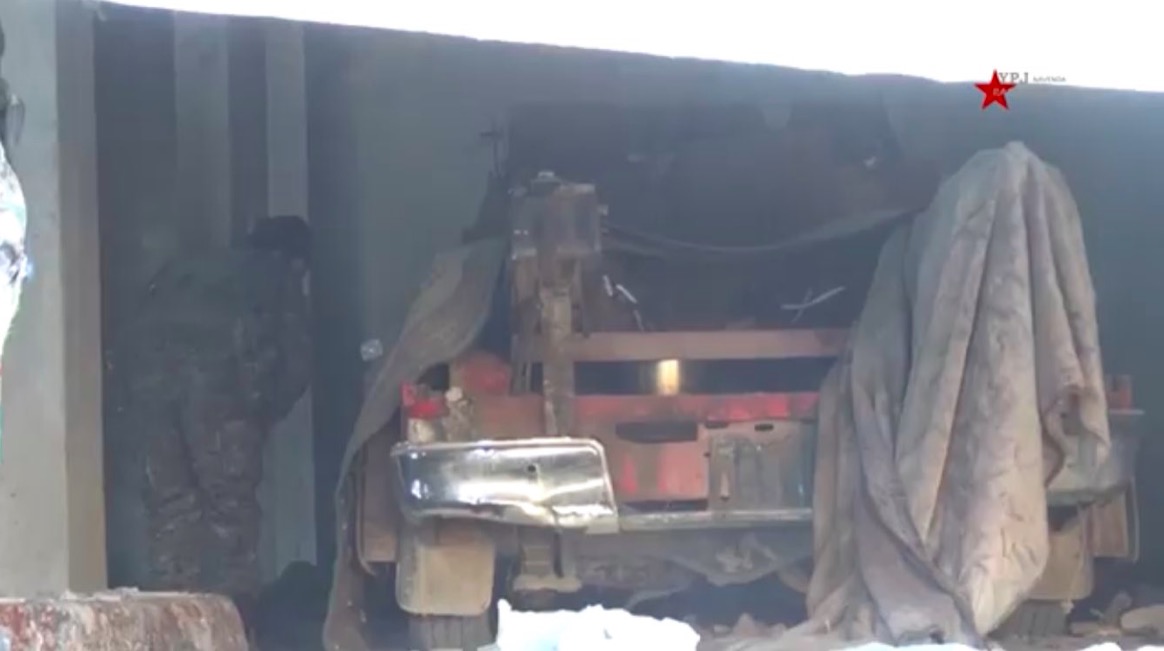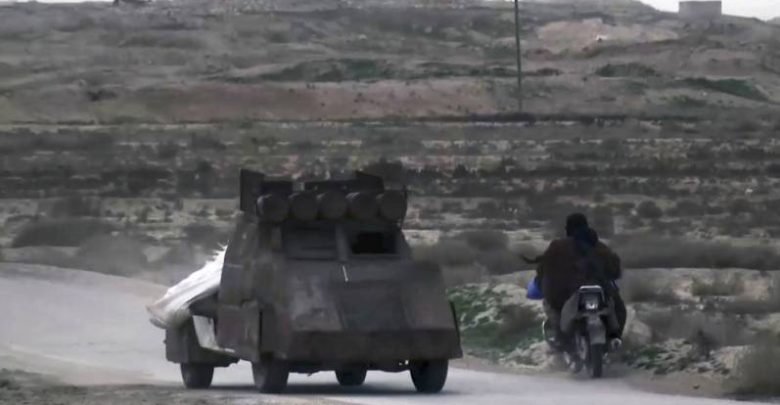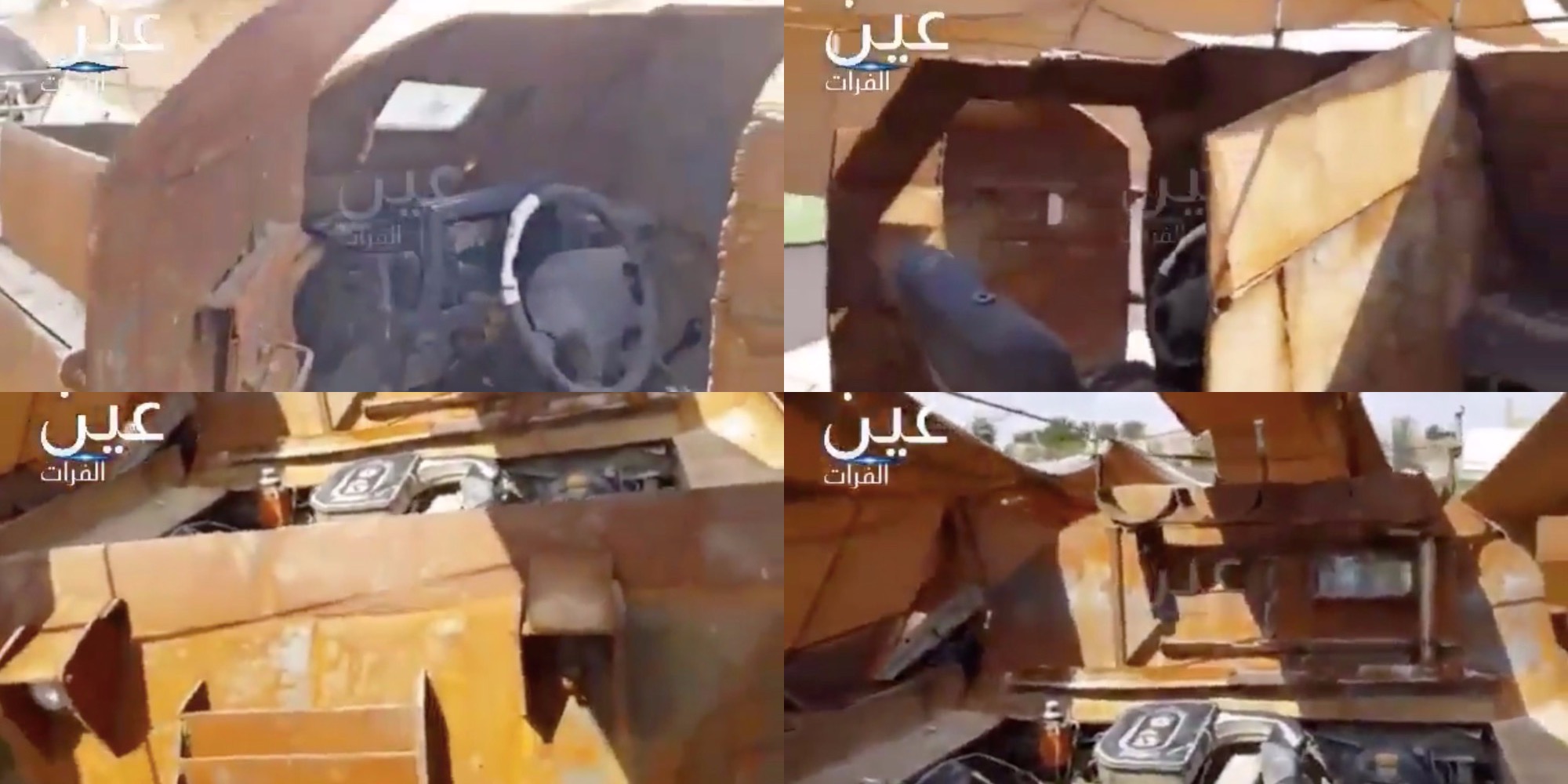In April 2019 I wrote the most comprehensive report of the Islamic State’s (hereafter IS) design and use of Suicide Vehicle-Borne Improvised Explosive Devices, or SVBIEDs, since the proclamation of the caliphate in 2014. The report, titled “Car Bombs as Weapons of War” and published by the Middle East Institute, was an attempt at chronicling the group’s efforts aimed at developing the designs and tactical use of their most powerful weapon, the SVBIED, in an ever-changing environment. Throughout the years, IS managed to manufacture thousands of overhauled vehicles for a variety of purposes, including a series of standardised target- and environment-specific designs. These have included everything from covert, up-armoured, two-man SVBIEDs to rocket-upgraded and the multiple stages of camouflaged SVBIEDs.
However, as the report was released immediately after the group’s loss of its final territory, their last SVBIED design innovation was in my opinion not given enough attention. This article can hence be considered as a complementary addition to my March 2019 MEI report.
BACKGROUND
During the battle of Mosul, IS began using what I like to call ‘camouflaged’ SVBIEDs. The mounted armour on these overhauled vehicles would be painted in the same color as the shell vehicle, and a later upgrade would see fake windshields, grilles and wheels painted in black added on top of the already painted armour. This was an attempt at emulating the characteristics of civilian vehicles while at the same time maintaining a considerable degree of armour on the vehicle. In turn, this was supposed to increase the reaction time of the Iraqi forces advancing in the city when they were met with the use of SVBIEDs, potentially allowing for the defending IS contingent to increase the success rate of such defensive attacks. (It should be noted that ‘camouflaged’ SVBIEDs were not the first environment-specific SVBIED designs. Desert-coloured up-armoured SVBIEDs had already been used for some time in the open plains and desert areas of Northern Iraq.)

As the fighting moved over the border and the battle of Raqqah intensified, a significant and widespread improvement to camouflaged SVBIEDs started being used by IS. Interior armour replaced the painted exterior armour, significantly increasing the stealthy character of the vehicles.

These designs would continue to be used sporadically beyond the battle of Raqqah, as the fighting moved through the central, Eastern Syrian deserts and down along the Euphrates river. As the fighting slowed down in early 2018 and began to settle around what would come to be called the ‘Hajin pocket’, IS were in fact still employing some camouflaged SVBIED designs, though the examples were of considerably lower quality.

HAJIN
The Hajin pocket was a string of villages situated along the final stretches of the Euphrates river before it crosses into Iraq. To give a basic understanding of the area, here’s how the territorial control in the area looked like on August 19, 2018.

Area-wise it wasn’t a particularly imposing piece of territory that IS controlled, but it had been massively saturated by waves of retreating IS fighters and their respective families for quite some time. For example, a large part of the IS contingent in Raqqah that was allowed to leave the city in October, 2017 as part of a deal with the Syrian Democratic Forces (SDF) eventually came to settle in towns in the Hajin pocket. With nowhere to flee and an abundance of fighters holed up in the area, the Hajin pocket would prove a hard nut to crack.
On October 22, 2018 the SDF seized an up-armoured SVBIED near the town of Mozan in the Hajin pocket. At first glance it looked like a standardised pick-up truck design, but interestingly enough it had multiple exterior IEDs facing forward mounted above the windshield armour.

While this would prove to be the first of many similar examples to come, the existence of frontal exterior payload charges was not an entirely new phenomenon. During the battle of Mosul IS had begun experimenting with its payload design, sometimes mounting anti-tank mines to the interior of the windshield and door armour. In a couple of examples, smaller IEDs would even be mounted to the frontal exterior of the armour kits in an effort to mimic headlights.
The first example visually similar to the Hajin design would appear in an official IS video from their Northern Iraqi ‘Jazirah province’ in November 2016. In mid-2017, an example with three frontal exterior aimed IEDs was seized by Iraqi forces in the desert between Tal Afar and Mosul. Finally, an example with a single frontal exterior IED would be captured by Syrian loyalist forces when they captured the city of al-Bukamal from IS in November, 2017. (Note: Curiously, al-Bukamal is situated directly across the Euphrates river from the Hajin pocket, where these designs would be standardised beginning in October, 2018)

However, it was never standardised, and all recorded cases came few and far in between. That would change in late October, 2018. Four days after the first SVBIED with frontal exterior IEDs was seized in the Hajin pocket, another example was captured.

While the first example had a fairly standard rear payload design, this example featured a significantly raised rear payload of 16 IEDs. The rear half of the IEDs were mounted pointing directly out to the side, while the forward half of the IEDs were mounted pointing approximately 45 degrees forward. This was clearly an attempt at directing as much of the explosive energy of the payload as possible forward and to the sides. That had also been the purpose behind most prior payload design experimentation, but it hadn’t been done at this scale before. The rough sketch below illustrates the thought behind this specific SVBIED design.

An official IS video release from the Hajin pocket published on November 5, 2018 featured another example of this SVBIED design. The design appeared similar to the one above with a raised rear payload, though more qualitative in nature. On top of that, it had been fitted with an extra set of 8 IEDs in the back passenger seats, all mounted forward at an angle.

Let’s pause for a moment and discuss the likely strategic reasoning behind the introduction of this specific SVBIED design. Because there is one. As I continuously pointed out in my MEI report from April 2019, there’s been some form of strategic reasoning behind all SVBIED designs and innovations over the years. To begin with, the reasoning behind the two basic designs are as follows:
- Covert SVBIEDs are employed in areas of little to no territorial control and necessitate emulating civilian vehicles in order to stealthily creep up on the designated target without being discovered.
- Up-armoured SVBIEDs are used in areas of significant territorial control with clear demarcated frontlines, and require armour plating in order to withstand incoming fire as they advance on their target.
Within the class of up-armoured SVBIEDs there has been an array of specific design innovations that can be divided into two sub-groups; beginning with target-specific designs and later crossing over into the mass-production and use of environment-specific designs.
Target-specific designs:
- Two-man SVBIEDs (and later rocket-upgraded SVBIEDs) are equipped with offensive weapons meant to suppress the target as the vehicle approaches, potentially increasing the success rate of such attacks on hard targets.
- Front-end loader & bulldozer SVBIEDs have commonly been used against targets surrounded by large defensive structures, or against targets where the road leading up to them have been littered with obstacles. The frontal buckets of these vehicles can move through most obstacles, remove earth berms, obstacles, and generally access areas where normal up-armoured SVBIEDs would have no chance of reaching.
Environment-specific designs:
- Desert-coloured SVBIEDs were an initial attempt at “camouflaging” up-armoured SVBIEDs by painting them in the same color as their surroundings (in this case, the wide plains and deserts commonly found across Northern Iraq and in central/Northern Syria.) This effort was meant to mask the vehicles’ approach and increase their success rate in areas where advancing cover was next to non-existent.
- Camouflaged SVBIEDs function the same way as desert-coloured SVBIEDs, but were specifically tailored for use within urban centers. By emulating the exterior characteristics of civilian vehicles in a sprawling city, the goal was to confuse Iraqi ground forces and aerial reconnaissance as IS launched defensive SVBIED attacks, increasing the former’s response time.
The evolution within environment-specific SVBIED designs follow a very clear chain of successive strategic reasoning. Desert-coloured SVBIEDs were used en masse exclusively in the wide and open desert plains, but were instantly replaced with different stages of camouflaged SVBIEDs once fighting entered major urban centers (such as Mosul and Raqqah). For example, this near-instantaneous shift from desert-coloured to camouflaged SVBIEDs was observed in both Eastern and Western Mosul.
So, how do the up-armoured SVBIEDs with frontal exterior IEDs fit into this? As was mentioned earlier, IS were still employing camouflaged SVBIEDs to a certain degree in the small villages scattered across the Hajin pocket in early 2018. The problem was that this design was specifically tailored for major urban centers, not minor remote villages. The geographical restrictions of the Hajin pocket, coupled with the excess of Coalition aerial reconnaissance aircraft monitoring the area, meant that the advantages of employing camouflaged SVBIEDs were severely limited. Instead, IS would choose to attempt to maximise the potential lethality of their constructions. As stealth was not a focus anymore, it made more sense for them to focus on the deadliness of the SVBIEDs, so that the result of any successful attack would be all the more destructive.
The use of aimed rear explosive payloads, as well as exterior frontal IEDs on some SVBIEDs is confusing. While it is clear what the aim behind the design is – to increase the deadliness of the blast by ‘directing the energy of the blast outwards to the sides and forward’ – there is little evidence of this actually working. The IEDs used in the standardized payloads of most SVBIEDs used by IS are normal multi-purpose IEDs, meaning that they can also be used in single roadside bomb attacks. In order to be able to properly direct the energy of the resulting blast, one would have to use explosively formed penetrators, or EFPs, that work according to the Misznay-Schardin effect. The few cases where suspected EFPs have been documented are the examples that include frontal exterior IEDs masked as headlights. And even so, they make up such a small percentage of the overall payload that it is unclear if it has any measurable effect on the end result.
As the fighting progressed in the Hajin pocket, more examples of this SVBIED design surfaced. On December 11 and 12 respectively, two more cases were featured in official IS videos and photo reports. The second example was the first based on an SUV seen up until that point.


After these two examples, the rest of December 2018 would not see any examples from official IS media. Instead, half a dozen SVBIEDs were captured by the SDF as they advanced. On December 14, the first example that was also desert-coloured was seized from IS in its forward hide site near Hajin before it could be used. (Note: After SVBIEDs are manufactured, they’re commonly transported to and stored in houses close to the frontline before they’re employed. If many SVBIEDs are captured in their forward hide sites in a short period of time, that’s usually a sign that the opposing force has managed to advance fast.)

Three days later on December 17, a video showing an up-armoured SVBIED based on a red pick-up truck that also featured mounted frontal exterior IEDs was uploaded by an SDF fighter. This vehicle was also seized in its forward hide site.
On December 18, two SVBIEDs were seized. The first example likely got stuck and was abandoned as it veered off the road into a field on the outskirts of Hajin city.


Video footage would later emerge, showing SDF personnel disposing of the vehicle by lighting a fuse and running off before the SVBIED detonated.
The second example was an up-armoured SVBIED based on an SUV that was seized in its forward hide site. A short video showing the vehicle was uploaded by an SDF fighter.
As 2018 turned into 2019, IS loss of SVBIEDs continued unabated. On January 13, an official SDF video showed two seized SVBIEDs. The first example was an up-armoured SVBIED based on a pick-up truck.

The second example was an up-armoured SVBIED based on an SUV. Both vehicles were outfitted with frontal exterior IEDs, and were captured in their forward hide sites.


On January 18, IS footage showed what by then had become the standardised “Hajin” SVBIED design before it raced off towards its target; an up-armoured pick-up truck with multiple frontal exterior IEDs.

Ten days later, the SDF would seize another desert-coloured variant of this standardised design between the villages of Baghouz and Marashida.


An interesting aspect of both these vehicles, as well as the first example recorded back in October 2018 was that they appeared to be designed for use as two-man SVBIEDs. In mid-April 2019, an official IS video from their North-eastern Iraqi province of ‘Diyala’ would include a brief sequence showcasing a previously unseen and undated two-man SVBIED used in the Hajin pocket. Standing in the rear bed of the vehicle directly behind the driver’s cabin, the gunner positioned himself with a light machine gun, preparing to suppress the target.

On January 31, another standardised “Hajin” SVBIED was seized in its forward hide site. It looked as if the vehicle either hadn’t been fully completed yet, or that SDF personnel already had dismantled the exterior mounted charges.

As the Hajin pocket continued to shrink on a daily basis, some captured SVBIEDs began exhibiting signs of having been hastily constructed. For example, the below example (captured in late February) had received quite a shoddy armour job, but was still outfitted with frontal exterior IEDs as well as an aimed rear payload. There seems to be degrees of prioritisation given to specific aspects of the SVBIED.


During his visit to the area in mid-March, Amman-based independent researcher and journalist Jared Szuba took photos of two previously unseen examples. The first example (left) was spotted near Hajin city on March 14, while the second example (right) was seen in a field west of Baghouz on March 17. Both had raised rear payloads that had been dismantled.

During clearing operations in the village of al-Shafa in late March, a “Hajin” SVBIED of very high quality was discovered in its forward hide site. The below video gives a very good visual overview of the design of the vehicle.

In the end, IS territorial presence in Syria would be reduced to a massive tent city in and around the village of Baghouz containing tens of thousands of IS fighters and their family members. After a standoff, repeated surrenders and at times intense fighting and bombardment, the encampment on the Northern banks of the Euphrates would finally be cleared of IS on March 23, 2019.

This is when perhaps the most interesting aspect in terms of SVBIEDs emerged. As SDF personnel cleared the tent city a week later, a large tent was discovered. But it wasn’t a tent like any other.

Pitched in the middle of an otherwise barren field, the tent was actually an SVBIED workshop containing a vehicle in the process of being converted.


This was astounding, and really signified the lengths to which IS went to in order to be able to uphold a continuous output of SVBIEDs despite the steady losses they had suffered up until that point. During the battles of Mosul and Raqqah, it was impressive but still understandable that IS were able to instantly change which SVBIED design they manufactured and used en masse depending on the environment they were fighting in at the moment. I mean, they had the resources and organisational structure that would allow for something like that to be implemented. But the fact that IS was still able to do that with the standardised “Hajin” SVBIED design beginning in October 2018 when they were on the brink of being territorially defeated was nothing less than impressive. The Baghouz tent workshop adds another level to that.
STATISTICS
In this section, I will present a statistical overview of some of the design and tactical aspects of the overall SVBIED output in the Hajin pocket between October 2018 and late March 2019. From beginning to finish, I managed to documented 20 separate examples used or captured within this specific time period.
Out of the 20 documented examples, the overwhelming majority (16) were based on pick-up trucks. The remaining 4 were based on SUVs. Similarly, the overwhelming majority (17) of all documented examples were of the standard up-armoured variety. A mere 3 examples were desert-coloured. Only 3 examples were of the two-man variety. Looking at the rear payload design, 13 were of the standard variety, while 7 were raised. The number of frontal exterior IEDs mounted on the SVBIEDs varied quite a bit, with examples equipped with between 2-5 recorded. However, the most common number of mounted exterior charges (out of those that could be visually counted) was 4, of which there were 7 cases.
This leaves us with perhaps the most significant piece of statistics. Out of all 20 documented examples, only 4 were featured in official IS media. Most of the SVBIEDs (a whopping 16!) were captured by the SDF before they could be used. That’s an awful number for IS.
CONCLUSION
This absolutely devastating ratio of used to captured numbers of SVBIEDs in the Hajin pocket is actually reminiscent of the latter stages of the battle of Mosul, when IS introduced the rocket-upgraded SVBIEDs. There too, the overwhelming majority of examples were captured before they could be used. The reason for this is simple; IS just couldn’t keep up with the continuous territorial losses. When the SDF advanced, IS failed to move their SVBIEDs stationed in forward hide sites further back, and instead lost them.
Despite their atrocious tactical performance in their last piece of territory, IS remained extremely proficient in their continued design and manufacturing of SVBIEDs. The emergence of the standardised “Hajin” SVBIED design with frontal exterior IEDs was a necessary innovation. Camouflaged SVBIEDs had already served their purpose, and a new design was called for that attempted to meet the needs of the limited territorial holdings IS possessed at the time. Instead of pouring resources into futile attempts at emulating civilian vehicles in the most surveilled battlefield at the time, IS focused on attempting to maximise the deadliness of the vehicles they manufactured. Even though the effect of this design is questionable, the intent behind its emergence is very clear.
If you enjoy reading what I write and post for free on my website and you can afford it, consider supporting my work with a dollar or two. It helps me out a lot. Thank you!



![Islamic State SVBIED development & innovation in the battle of Mosul [Case study for Jane’s Terrorism & Insurgency Center]](https://hugokaaman.com/wp-content/uploads/2017/05/haul-truck-300x169.png)

Giles Longley-Cook
30 Aug 2019Excellent post, and blog in general. The one question I have is this: in many photos and footage, the drivers of these SVBIED’s seem to be wearing bomb belts, which I guess is to add to the explosive payload, but also their ammo rigs. Some even seem to be taking their rifles with them. Any idea why they’d waste equipment like that?
Be interesting in general to hear your analysis on bomb belt/vest designs and tactics used as well if that’s something you’d cover.
Tahsin
25 Dec 2019Since they are handicapped I would assume they have the bomb vests in order if they are stuck in the mud or if they do get captured. And rifles are not expensive in the middle east.